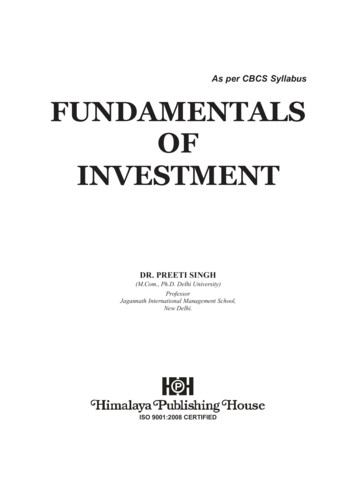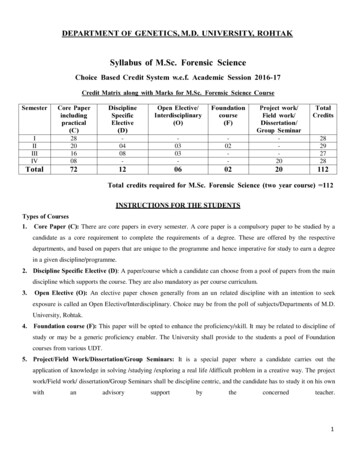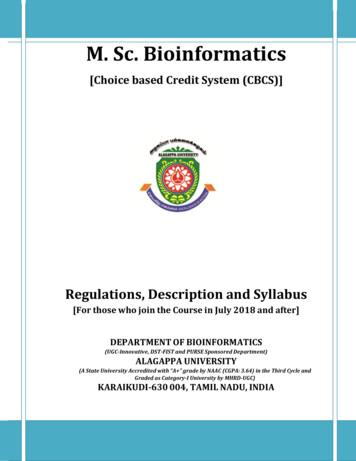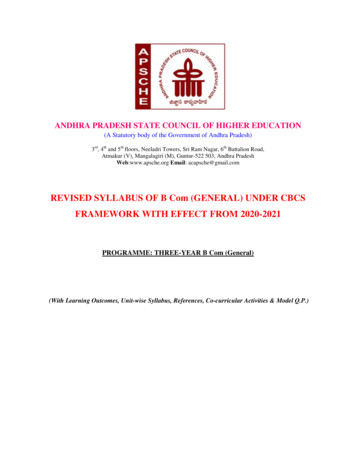
Transcription
As per CBCS SyllabusFUNDAMENTALSOFINVESTMENTDR. PREETI SINGH(M.Com., Ph.D. Delhi University)ProfessorJagannath International Management School,New Delhi.ISO 9001:2008 CERTIFIED
AuthorNo part of this publication may be reproduced, stored in a retrieval system, or transmitted inany form or by any means, electronic, mechanical, photocopying, recording and/orotherwise without the prior written permission of the publisher.First Edition : 2018Published by: Mrs. Meena Pandey for Himalaya Publishing House Pvt. Ltd.,“Ramdoot”, Dr. Bhalerao Marg, Girgaon, Mumbai - 400 004.Phone: 022-23860170, 23863863; Fax: 022-23877178E-mail: himpub@vsnl.com; Website: www.himpub.comBranch Offices:New Delhi: “Pooja Apartments”, 4-B, Murari Lal Street, Ansari Road, Darya Ganj, NewDelhi - 110 002. Phone: 011-23270392, 23278631; Fax: 011-23256286Nagpur: Kundanlal Chandak Industrial Estate, Ghat Road, Nagpur - 440 018.Phone: 0712-2738731, 3296733; Telefax: 0712-2721216Bengaluru: Plot No. 91-33, 2nd Main Road, Seshadripuram, Behind Nataraja Theatre,Bengaluru - 560 020. Phone: 080-41138821; Mobile: 09379847017,09379847005Hyderabad: No. 3-4-184, Lingampally, Besides Raghavendra Swamy Matham,Kachiguda, Hyderabad - 500 027. Phone: 040-27560041, 27550139Chennai: New No. 48/2, Old No. 28/2, Ground Floor, Sarangapani Street, T. Nagar,Chennai - 600 012. Mobile: 09380460419Pune: First Floor, “Laksha” Apartment, No. 527, Mehunpura, Shaniwarpeth (NearPrabhat Theatre), Pune - 411 030. Phone: 020-24496323, 24496333;Mobile: 09370579333Lucknow: House No. 731, Shekhupura Colony, Near B.D. Convent School, Aliganj,Lucknow - 226 022. Phone: 0522-4012353; Mobile: 09307501549Ahmedabad: 114, “SHAIL”, 1st Floor, Opp. Madhu Sudan House, C.G. Road, NavrangPura, Ahmedabad - 380 009. Phone: 079-26560126; Mobile: 09377088847Ernakulam: 39/176 (New No. 60/251) 1st Floor, Karikkamuri Road, Ernakulam,Kochi - 682 011. Phone: 0484-2378012, 2378016; Mobile: 09387122121Bhubaneswar : Plot No. 214/1342/1589, Budheswari Colony,Behind Durga Mandap, Laxmisagar, Bhubaneswar - 751 006.Phone: 0674-2575129; Mobile: 09338746007KolkataDTP byPrinted at: 108/4, Beliaghata Main Road, Near ID Hospital, Opp. SBI Bank,Kolkata - 700 010. Phone: 033-32449649; Mobile: 07439040301: Elite-Art, New Delhi: M/s Sri Sai Art Printer, Hyderabad. On behalf of HPH.
PREFACEThis book on ‘Fundamentals of Investment’ has been written as an introduction to areader to be aware of the different types of securities in the market and to construct aportfolio of their funds. The investor has to select the right avenue for investments becausesavings must be utilized in a suitable manner. In India, several changes can be seen in thestock markets. It is dynamic in nature and changes are very frequent. It is fascinating andexciting and students find the world of investments very interesting as they think that theywill become ‘super rich’ in a shortwhile through trading on the stock market. This book isfor those investors who not only want to trade but also to save money and plan for a longterm period of time. Such investors are required to calculate risk and return framework andhold the investments over a period of time to get good returns.This book explains to the investors the pitfalls of investments and makes them aware ofdifferent kinds of available investments opportunities. It discusses the different theories ofinvestment which they should know before making an investment. They should alsounderstand that no one investor can constantly outperform the market.The book explains the importance of risk and return and how risk should be measured tomatch the expectation level of the investor. It explains the functions of the financial markets,the interlinking between the new issue market and stock exchange and a basic understandingof how to manage a portfolio through careful risk and return analysis.This book provides the theories of fundamental analysis, technical analysis and efficientmarket theory to analyze investments. The work of the pioneers like Harry Markowitz andWilliam Sharpe have been discussed for making an analysis of the portfolio and to diversifyit, to get the maximum return.This book has been written for students of management, commerce, accounting and financewho would like an exposure to the investment environment in India. It is a simple, studentfriendly book with many examples, solved illustrations, objective type questions, importantpoints, concepts and latest developments in Indian stock markets. The book has thirteenchapters and has been divided into five Units. Unit One discusses the Investment Environment, consisting of four Chapters. Theseare Introduction to Investment Management, The Indian Securities Market, Trading ofSecurities and Risk and Return. Unit Two explains valuation of Fixed Income Securities in Chapter 5. Unit Three consists of four chapters. It gives the different approaches to EquityAnalysis. Chapters 6, 7, 8 and 9 give the investor various techniques of investing intoequities based on theories for equity analysis. Chapter 6 gives the valuation techniques
of equity shares as an Investment. Fundamental Analysis is the subject matter ofChapter 7 while Chapter 8 shows the technical analysis focused mainly on Dow Theoryof analyzing stocks through charts, bar diagrams and moving averages. Chapter 9discusses the efficient market theory and in particular the Random Walk Theory. Unit Four covers basic portfolio management, mutual funds and other investmentalternatives and financial derivatives. Unit Five is on investor protection measures by Securities and Exchange Board ofIndia (SEBI) which plays the role of a regulator and develops the new issue and stockmarketThis book has been incorporated according to the new syllabus of Orissa University.Finally, I would like to acknowledge the constant encouragement of my publishersM/s Himalaya Publishing House particularly Mr. Niraj Pandey and production coordinatorNimisha Kadam.I would like to thank Brajendra Kumar for the secretarial assistance in preparing themanuscript of this book.Finally, I would like to thank all my students who have supported my work and givensuggestions and feedback. I welcome comments and suggestions by all the readers andstudents.Dr. Preeti Singh
CONTENTSUnit I: Investment Environment1.Introduction to Investment ManagementIntroductionUnderstanding the Term InvestmentFinancial and Economic Meaning of InvestmentInvestment and SpeculationInvestment and GamblingInvestment and ArbitrageReal and Financial AssetsWhy are Investments Important?Factors Favourable for InvestmentRisk-less vs. Risky InvestmentInvestment Alternatives/MediaFeatures of an Investment ProgramThe Investment Process - Stages in Investment2.The Indian Securities MarketFinancial System: An IntroductionIndian Securities MarketParticipants in the Securities MarketOther Financial MarketsMarket Intermediaries/ParticipantsFinancial InstrumentsFinancial Engineering InstrumentsSecurity Market IndicesSources of Financial Information3 – 213344667891213161722 – 36222324242727283032
3.Trading of SecuritiesThe Relationship of the New Issue Market and Stock ExchangeStructure of the Indian Capital Market with ParticipantsIntermediaries/Participants in the New Issue MarketIssue of Capital in New Issue MarketFunctions of the New Issue/Primary MarketSecondary/Stock MarketsListing of SecuritiesDepository System or Paperless TradingBroker System of Trading of SecuritiesControl of Indian Capital Market: SEBIDevelopments in the Stock MarketImportant Stock Markets in India: NSE, BSE, OTCEI, ISE, NCDEX4.Risk and ReturnRisk and ReturnInvestor’s Attitude towards Return and RiskTypes of Risk — Systematic and UnsystematicSystematic RiskUn-systematic RiskMeasurement of RiskReturnMeasurement of ReturnCapital Asset Pricing Model (CAPM Model): Share ValuationImpact of Taxes on InvestmentImpact of Inflation on ReturnBeta as a Measure of Risk37 – 8737383943465152555868707888 – 121889093949798104104107108109109Unit II: Fixed Income Securities5.Fixed Income Securities Analysis and ValuationDebt InstrumentsFeatures of Bonds and DebenturesThe Bond IndentureRegulation of Bonds in IndiaTypes of Bonds/Debentures125 – 173125126129129130
Objectives of Issuing BondsCredit RatingBond YieldBond ValuationBond Value, Market Interest Rate and Coupon RateValuation of Preference Shares136136139145152158Unit III: Approaches to Equity Analysis6.Equity Stock as an InvestmentIntroductionFeatures of Equity SharesEquity Shares as an InvestmentEquity Shares ValuationValuation of Equity Shares – Accounting ConceptValuation of Equity Shares – Dividend ConceptValuation of Equity shares – Earnings Concept7.Fundamental AnalysisIntroduction to Fundamental AnalysisEconomic AnalysisIndustry AnalysisCompany AnalysisRatios Relevant for Equity ShareholdersEconomic Value Added (EVA)Sources of Financial Information8.Technical AnalysisIntroductionDistinction between Technical and Fundamental AnalysisThe Dow TheoryType of ChartsConstruction of ChartsOther Theories177 – 204177177179180180181186205 – 232205206207209211222223233 – 251233234235241243244
9.Theory of Contrary OpinionAnalysis of IndicatorsLimitation of Technical Analysis245247248Efficient Market Theory252 – 264IntroductionConcept of Efficient Market TheoryEfficient Market HypothesisWeak FormSemi Strong FormStrong FormEmpirical AnalysisRandom Walk Conclusions252253254255255255256261Unit IV: Portfolio Analysis and Financial Derivatives10.Portfolio ManagementIntroductionTraditional vs. Modern Portfolio AnalysisModern Portfolio TheoriesThe Rationale of Diversification of InvestmentsThe Effect of Combining Two Securities: Risk and ReturnInteractive Risk through CovarianceTheories of Portfolio Selection and ManagementMarkowitz Model — Portfolio TheoryCapital Market Theory — Capital Asset Pricing Model (CAPM)Distinction between Capital Market Line and Security Market Line11.Mutual Funds and Other InvestmentsIntroductionConcept of Mutual FundsFeatures of Mutual FundsStructures of a Mutual FundMutual Funds in IndiaGrowth of Mutual Fund Industry in India267 – 310267267269269270272278279287293311 – 335311311311312313315
Mutual Fund SchemesPlans of Mutual FundsNet Asset ValueCosts and Loads in Mutual Fund InvestmentsReturn from Mutual FundSEBI and Mutual Fund RegulationReview of Mutual Funds as Investment Option in IndiaOther Forms of Investments12.Financial DerivativesDerivativesTypes of DerivativesCharacteristics of DerivativesParticipants in Derivatives MarketFinancial DerivativesTypes of TransactionsForward ContractsOptionsFuturesSwapsDerivatives Market in India317320321321322323324325336 – 362336337338339339340340341349351353Unit V: Investor Protection13.Securities and Exchange Board of IndiaIntroductionGuidelines for Investor ProtectionInvestor Protection and Guidelines for CompaniesListed Companies and Model Code of ConductInvestor GrievancesDepartments of SEBI and Their ActivitiesOMBUDSMAN 2003National Stock Exchange and Arbitration FacilitiesInvestor EducationProhibition of Fraudulent and Unfair Trade Practices Relating toSecurities Market Regulation365 – 374365366366367367368368369369370
Prohibition of Insider TradingDisclosure of InterestMAPINInvestors' Protection Fund370371372372Annexure375 – 386Glossary387 – 403Index404 – 406
UNIT IINVESTMENT ENVIRONMENTChapter 1:Introduction to Investment ManagementChapter 2 :The Indian Securities MarketChapter 3 :Trading of SecuritiesChapter 4 :Risk and Return
1INTRODUCTION TO INVESTMENTMANAGEMENTContents of this Chapter1.1 Introduction1.2 Understanding the Term Investment1.3 Financial and Economic Meaning of Investment1.4 Investment and Speculation1.5 Investment and Gambling1.6 Investment and Arbitrage1.7 Real and Financial Assets1.8 Why are Investments Important?1.9 Factors Favourable for Investment1.10 Risk-less vs. risky investment1.11 Investment Alternatives/Media1.12 Features of an Investment Program1.13 The Investment Process - Stages in Investment1.1 INTRODUCTIONMoney does not have any value unless it is invested. If a person has a large sum of moneyand he keeps it in his cupboard it will not grow. It has to be invested in some financial assetto get a return. There can be no return without risk. It is within this framework of risk andreturn that investment has to be made. It is assumed that a person is risk averse and at thesame time he expects a good return on the money that he invests. Therefore, an investor hasto trade-off between risk and return. This chapter is an introduction to the terms investment,speculation and gambling. It also presents the media for investments and explains theinvestment process.1.2 UNDERSTANDING THE TERM INVESTMENTInvestment is the commitment of funds with a long-term time framework the objective beingadditional income to regular receipts and growth in the value of funds of an investor.Investment involves ‘waiting’ for a future reward in terms of income through regular interest,dividends, premiums, or appreciation in the value of the principal capital. The term‘Investment’ is understood differently by economists and financial experts. Economistsconsider it as new and productive capital and financial experts emphasize on allocation andtransfer of resources from one person to another. It is also different to the terms speculationand gambling and they differ in terms of risk, time frame-work and gains.
4 Fundamentals of InvestmentIt must be clearly established that investment involves long-term commitment.Financial and Economic meaning of investment are different and must be understood interms of use of capital.Investment speculation and gambling can be distinguished from each other through theirrisk, time period of commitment and gains.1.3 FINANCIAL AND ECONOMIC MEANING OF INVESTMENTFinancial Investments are the allocation of monetary resources ranging from risk free torisky investments and with the expectation of a good return that varies with risk. The investorhas to aim at a trade-off between risk and return. The investors are the suppliers of ‘capital’and in their view, investment is a commitment of a person’s funds to derive future income inthe form of interest, dividends, rent, premiums, pension benefits or the appreciation of thevalue of their principal capital. To the financial investor, it is not important whether money isinvested for a productive use or for the purchase of secondhand instruments such as existingshares and stocks listed on the stock exchanges. Most investments are considered to betransfers of financial assets from one person to another.The economist understands the term ‘Investment’ as net additions to the economy’s capitalstock which consists of goods and service that are used in the production of other goods andservices. For them, the term investment implies the formation of new and productive capitalin the form of new construction, new producers’ durable equipment such as plant andequipment, including inventories and human capital.The financial and economic meaning of investment cannot be separated because the termdraws a relationship with the economists and financial experts. Investment is a part of thesavings of individuals which flow into the capital market either directly or throughinstitutions; they may be divided in ‘new’ or ‘secondhand’ capital financing. Investors as‘suppliers’ and investor as ‘users’ of long-term funds find a meeting place in the market.In this book, however, investment will be used in its ‘financial sense’ and investment willinclude those instruments and institutional media into which savings are placed.1.4 INVESTMENT AND SPECULATIONInvestment is distinguished from speculation in three ways which are based on the factors ofrisk, time period and gains.1. RiskThe term ‘risk’ has significance in the financial meaning of investment. Whatever amount isinvested has the probability of incurring a gain or a loss in a financial transaction.Investment is not considered to involve high risk but it has limited risk and risk can becalculated through different techniques and the capital can be invested in avenues where theprincipal is safe. ‘Speculation’ is correlated with ‘high risk’ and short commitment. There aredegrees of risk, and arbitrary judgements are made between high risk and low risk. Aninvestor cannot have completely risk-free investments because there are certain non
Introduction to Investment Management5controllable risks that cannot be calculated. The purchasing power risk or the fall in the realvalue of the interest and principal is beyond the control of a person. The money rate risk orthe fall in market value, with the rise in interest rates also cannot be controlled.These risks affect both the speculator and the investor. High risk and low risk are, therefore,general indicators to help an understanding between the terms investment and speculation.2. Capital GainSpeculation is buying low and selling high in a short time to make large capital gains. Themotive in speculation is primarily to achieve profits through price changes. This can bedistinguished from investment where securities are purchased by an investor through properevaluation, analysis and review with the view of receiving a stable return over a long-termperiod of time.3. TimeTime period explains the difference between investment and speculation. A fund allocationover a long-term period is called investment. A short-term holding is associated with tradingfor the ‘quick turn’ and is called speculation. The speculator is not interested in holding asecurity for current income but for high short-term gains.The distinctions between investment and speculation help to identify the role of the investorand speculator. To summarize the above discussion:The investor constantly evaluates the worth of a security through fundamental analysis,whereas the speculator is interested in market action and price movement.1. There is a very fine line of division between investment and speculation. There are noestablished rules and laws that identify securities which are permanently for investment.There has to be a constant review of securities to find out whether it is a suitableinvestment for long-term or for quick turn of speculative profit. Long-term commitmentbecomes investment of the same security which if sold immediately on purchase only forprofit becomes speculation.2. Some financial experts have called investment ‘a well grounded and carefully plannedspeculation’, or good investment is a successful speculation. Speculation is planned shortterm investment based on haunches and beliefs. Investment is planned, evaluated andanalyzed long-term commitment of funds.3. Speculation is to achieve high returns though risk of loss is high. Investments are forminimizing risk of investors with the expectation of high returns. Therefore, investmentand speculation are a planning of risks.4. A speculator expects high return for his investment and to make gains he can commit hisown funds as well as use borrowed funds. An investor is cautious by nature and usuallyuses his own funds for investing in securities.
6Fundamentals of InvestmentThe distinction between investment and speculation is given in Table 1.TABLE 1: Distinction between Investment and rmtimebeyond 12 months.framework Short term planning holding assets evenfor one day.RiskIt has limited risk.ReturnIt is consistent and moderate over There are high profits and gains as wella long period.as high losses. It is not consistent.Use of fundsThe investor uses his own fundsthrough savings.Decisionsbehaviorinformation,Safety, liquidity, profitability and Marketstabilityconsiderationsand judgments on movement in the stockmarket. Haunches and beliefs.performance of companies.High Returns though risk of loss ishigh.Speculation isborrowed funds.throughownand1.5 INVESTMENT AND GAMBLINGGambling is artificial and unnecessary risk created for increased expected returns. Thedifference between investment and gambling is very clear. From the above discussion, it isestablished that investment is an attempt to carefully plan, evaluate and allocate funds invarious investment outlets which offers safety of principal, moderate and continuous returnsand long-term commitment.Gambling is quite the opposite of investment. It connotes high risk and the expectation ofhigh returns. It consists of uncertainty and high stakes for thrill and excitement. Typicalexamples of gambling are horse racing, game of cards, lottery, etc. Gambling is based on tips,rumors and hunches, it is unplanned, non-scientific and without knowledge of the exactnature of risk.The distinctions between investment, speculation and gambling give us a basic idea of theirnature, purpose and role.1.6 INVESTMENT AND ARBITRAGEInvestment is planned commitment of funds from a person savings into different outlets withthe expectation of safe, stable and fare return. Arbitrage is the mechanism of minimizing riskthrough hedging and taking advantage of price differences in different markets. An arbitragetransaction is the simultaneous purchase of the same or similar security in two differentmarkets. Short-term gains can be expected through such transactions. An investor can also bean arbitrageur if he buys and sells securities in more than one stock exchange to takeadvantage of the price differentials in such exchanges. Derivatives introduced in the Indianmarket have a great potential for arbitrage transactions. Arbitrage transactions help inenhancing efficiency and liquidity in the stock market and in increasing the volume of trade.
7Introduction to Investment ManagementHedgers, speculators and arbitrageurs can minimize risks and make profits through thearbitrage process.1.7 REAL AND FINANCIAL ASSETSReal assets are tangible goods in possession of a person. Financial securities represent papersthat are dependant on real assets for creating wealth.1. Real AssetsReal assets are used to produce goods or services. They are tangible assets that have aphysical form. Some examples of real assets are land and buildings, furniture, gold, silver,diamonds, or artifacts. They may be marketable or nonmarketable. They may also have thefeature of being moveable or non-moveable.2. Financial AssetsFinancial assets are called paper securities. Some examples of these assets are shares, bonds,debentures, bills, loans, lease, derivatives and fixed deposits. Financial assets represent aclaim by securities, on the income generated by real assets of some other parties. Such assetscan be easily traded, as they are marketable and transferable. Financial assets are transactionsbetween two or more parties for example if a person takes an insurance policy of 1,00,000of Life Insurance Corporation. The contract is a liability of LIC but an asset of the personinsuring himself because he has a claim over the insurance company to receive the principalsum with interest on the happening of an event or on the completion of a certain number ofyears.TABLE 2 : Distinction between Real and Financial AssetsReal AssetsFinancial AssetsLand and building, furniture, machineryShares, debentures, bonds,fixed deposits, bills, loansderivatives,Tangible assets moveable, immoveable,marketable and non – marketable.These are called paper securities as theydeal with claims generated on the issuer.Theses assets are used for production of Theseassetsarefinancialgoods and servicesrepresented by securitiesclaims3. Commodity AssetsCommodities are a new form of investment in India. Examples of commodity assets arewheat, sugar, potatoes, rubber, coffee and other grains. Commodities are also in the form ofmetal like gold, silver, aluminum and copper. Cotton, crude oil and foreign currency are otherexamples of commodities. Importers and exporters invest in commodities to diversify theirportfolios. Traders hedge or transact in commodities to make gains. A National Commodityand Derivatives Exchange Ltd. (NCDEX) has been setup in India in 2003 as a public limitedcompany to transact in commodities.
8Fundamentals of InvestmentThe promoters of NCDEX were ICICI Bank Ltd., National Bank for Agriculture and RuralDevelopment (NABARD), Life Insurance Corporation of India, Punjab National Bank,Canara Bank, CRISIL Ltd., Indian Farmers Fertilizer, Cooperative Ltd. (IFFCO) and NationalStock Exchange of India Ltd. (NSE). All these institutions subscribed to the equity shares ofNCDEX.The above explanations of the terms of investment have provided a background to themeaning of investment, this chapter now presents the importance of investments,opportunities conducive to investment, media available for investment, investment featuresand the process of investment.1.8 WHY ARE INVESTMENTS IMPORTANT?Investments are important due to increase in life expectancy of a person, planning forretirement income, high planning for additional income due to high rates of taxation andinflationary pressure in an economy, the expectation of continuous stable income in the formof regular dividends, interests and other receipts. The following discussion provides anexplanation of these issues.1. Longer Life ExpectancyInvestment decisions have become significant because statistics show that life expectancy hasincreased with good medical care. People usually retire between the ages of 60 and 65. Theincome shrinks at the time of retirement because the annual inflow of earnings fromemployment stops. If savings are invested at the right age and time wealth increases if theprincipal sum is invested adequately in different saving schemes.The importance of investment decisions is enhanced by the fact that there is an increasingnumber of women are working in organizations. Men and women are responsible for planningtheir own investments during their working life so that after retirement they are able to have astable income through balanced investments.2. TaxationTaxation introduces an element of compulsion in a person’s savings. Every country hasdifferent tax saving schemes for bringing down taxation levels of a person. Since investmentsprovide regular and stable income and also give relief in taxation they are considered to bevery important and useful if investments are made by proper planning.3. Interest RatesInterest rates vary according to the choice of investment outlet. Investors prefer safeinvestments with a good return. A risk-less security will bring low rates of return.Government securities are risk free. However, market risk is high with high rates of return.Before allocations of any amount the different types of securities must be analyzed tocalculate their benefits and their disadvantages. The investor should make his portfolio with
Introduction to Investment Management9several kinds of investments. Stability of interest is as important as receiving a high rate ofinterest. This book is concerned with determining that the investor is getting an acceptablereturn commensurate with the risks that are taken.4. InflationIn a developing economy there are rising prices and inflationary trends. A rise in prices hasseveral problems coupled with a falling standard of living. Before funds are invested, theymust be evaluated to find the right choice of investments to tide over inflationary situations.The investor will look at different investment outlets and compare the rate of return/interestto cover the risk of inflation. Security and safety of capital is important therefore he/sheshould invest in those securities that have an assured and regular return. An investor has toconsider the taxation benefit decides the safety of capital and its continuous return.5. IncomeInvestment decisions are important due the general increase in employment opportunities andan understanding of investment channels for saving in India. New and well paying jobopportunities are in sectors like software technology; business processing offices, call centres,exports, media, tourism, hospitality, manufacturing sector, banks, insurance and financialservices. The employment opportunities gave rise to increasing incomes. Higher income hasincreased a demand for investments and earnings above the regular income of people.Investment outlets can be selected to make investments for supporting the regular income.Awareness of financial assets and real assets has led to the ability and willingness of workingpeople to save and invest their funds for return in their lean period leading to the importanceof investments.6. Investment outletsThe availability of a large number of investment outlets has made investments useful animportant. Apart from putting aside savings in savings banks where interest is low, investorshave the choice of a variety of instruments. The question to reason out is which is the mostsuitable channel? Which investment will give a balanced growth and stability of return? Theinvestor in his choice of investment has the objective of a proper mix between high rate ofreturn and stability of return to get the benefits of both types of investments.Thus, the objectives of investment are to achieve a good rate of return in the future,reducing risk to get a good return, liquidity in time of emergencies, safety of funds byselecting the right avenues of investments and a hedge against inflation.1.9 FACTORS FAVOURABLE FOR INVESTMENTThe investment market should have a favourable environment to function effectively.Business activities are marked by social, economic and political considerations. It isimportant that the economic and political factors are favourable. Generally, there are fourbasic considerations which foster growth and bring opportunities for investment. These are
10Fundamentals of Investmentlegal safeguards, stable currency and existence of financial institutions to aid savings andforms of business organization.1. Legal SafeguardsA stable government which frames adequate legal safeguards encourages accumulation ofsavin
Fundamental Analysis 205 – 232 Introduction to Fundamental Analysis 205 Economic Analysis 206 Industry Analysis 207 Company Analysis 209 Ratios Relevant for Equity Shareholders 211 Economic Value Added (EVA) 222 Sources of Financial Information 223 8. Technical Analysis 233 – 2










